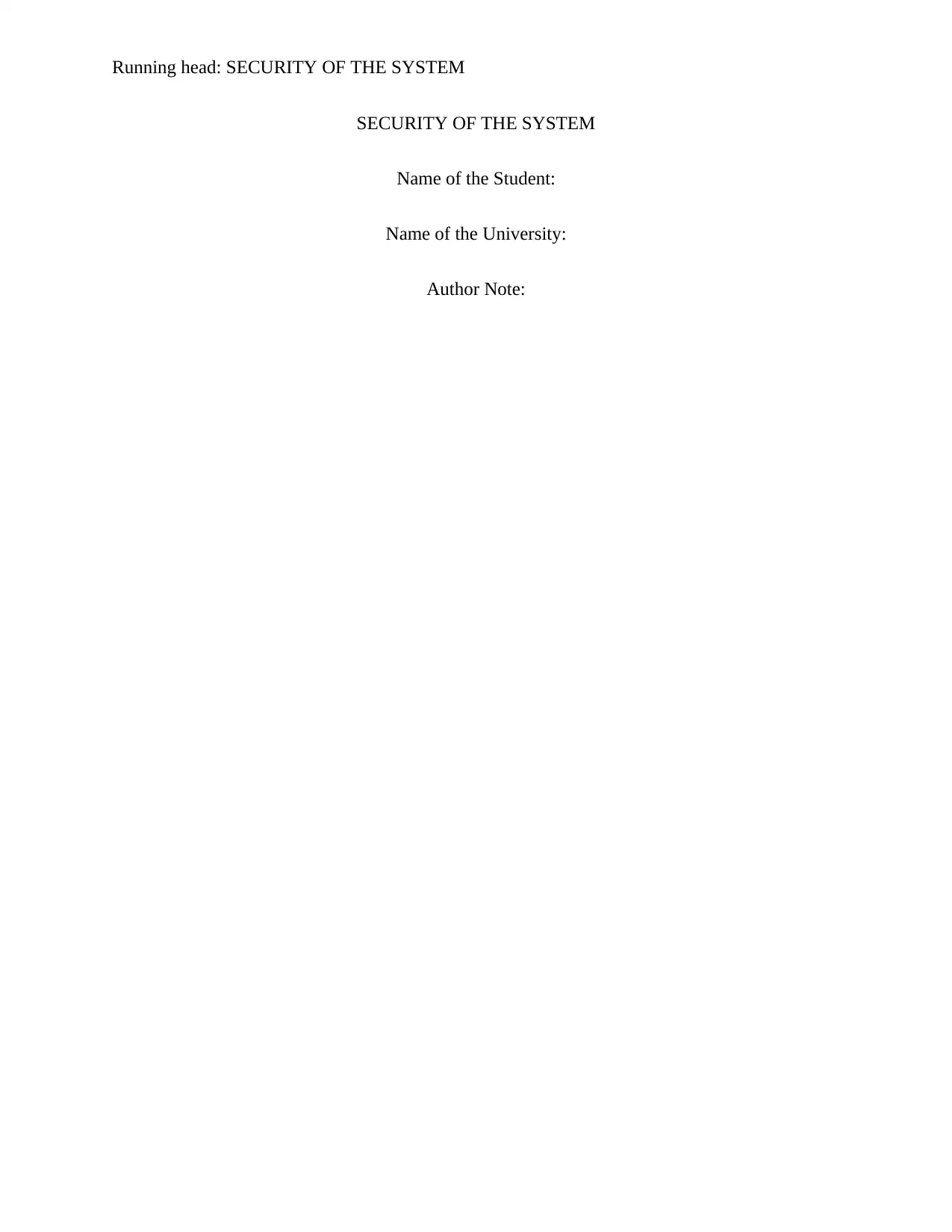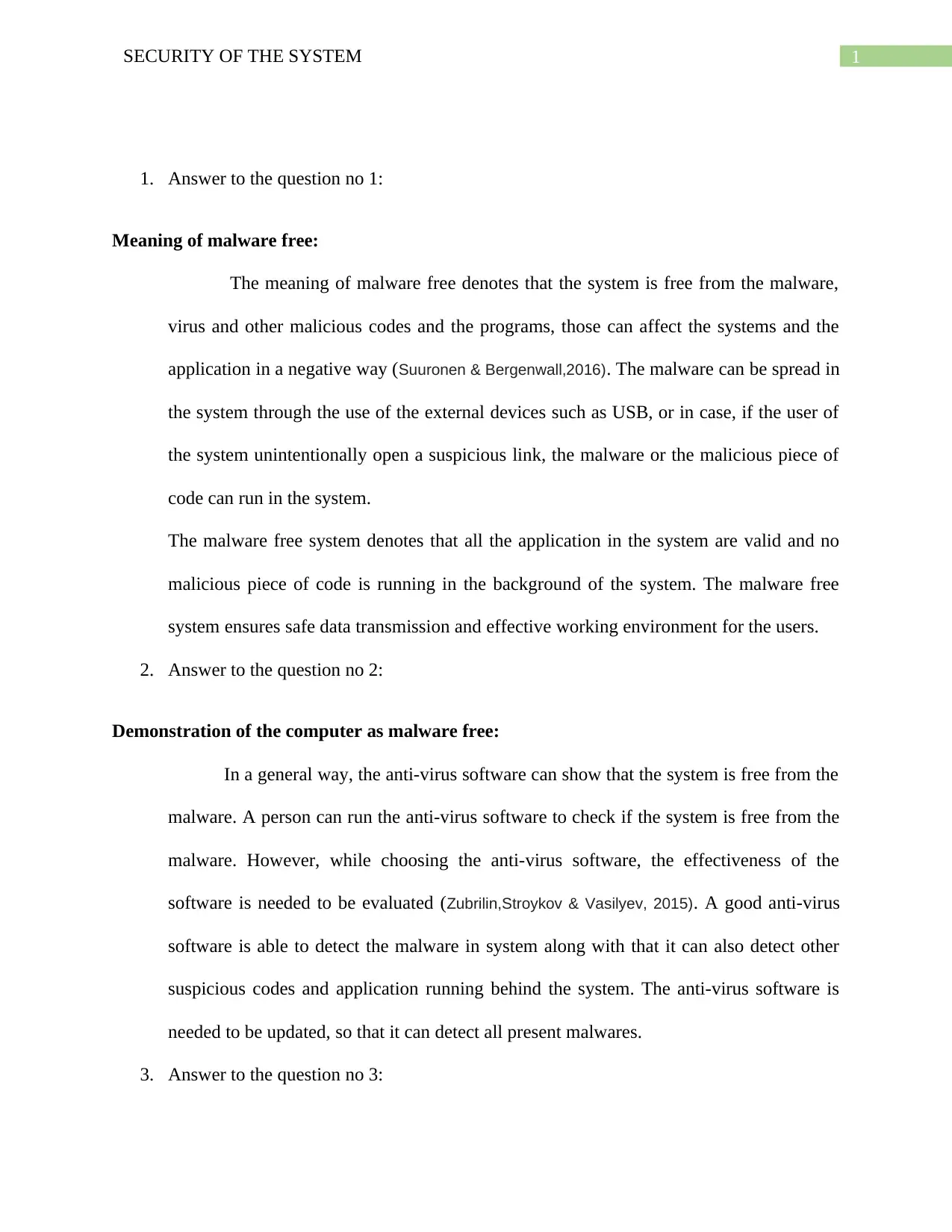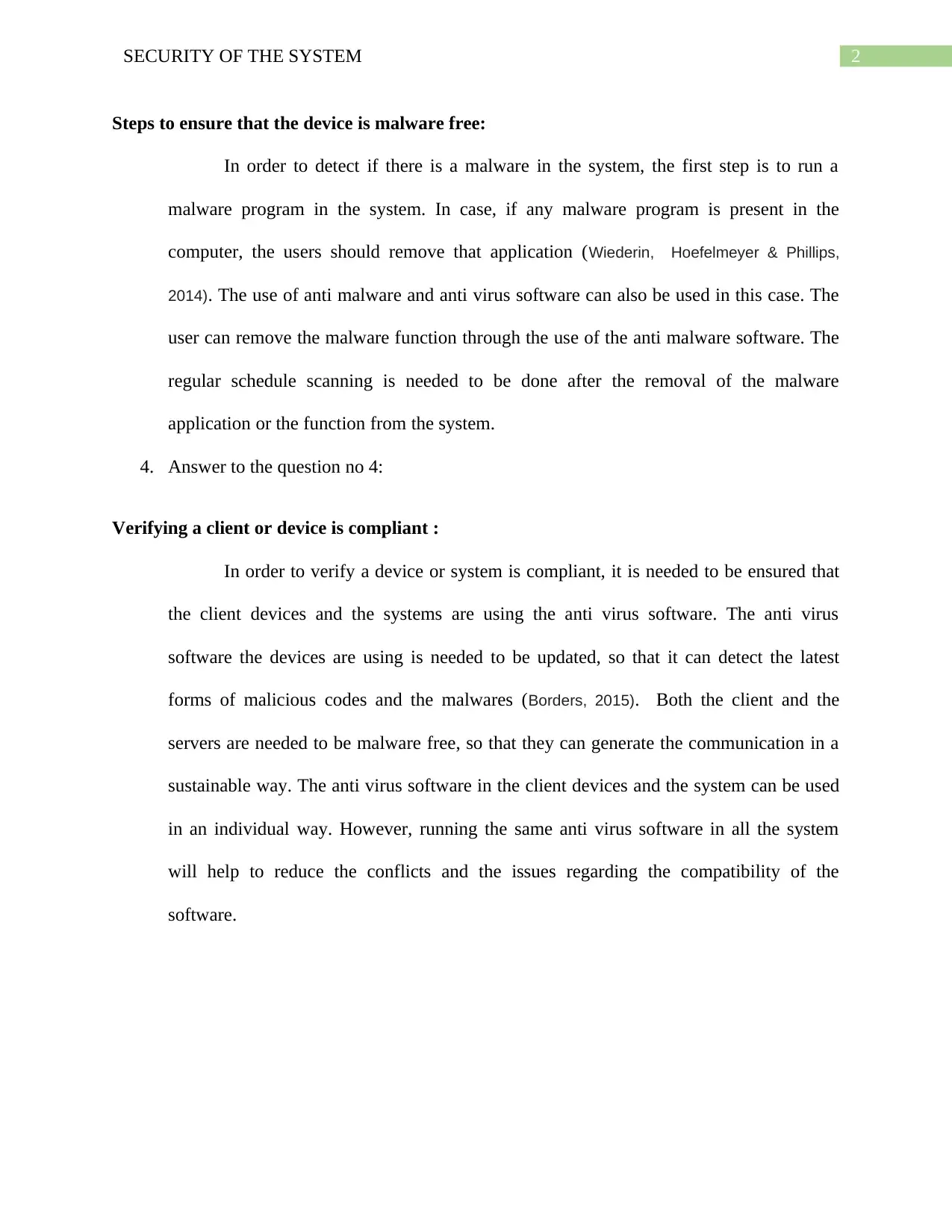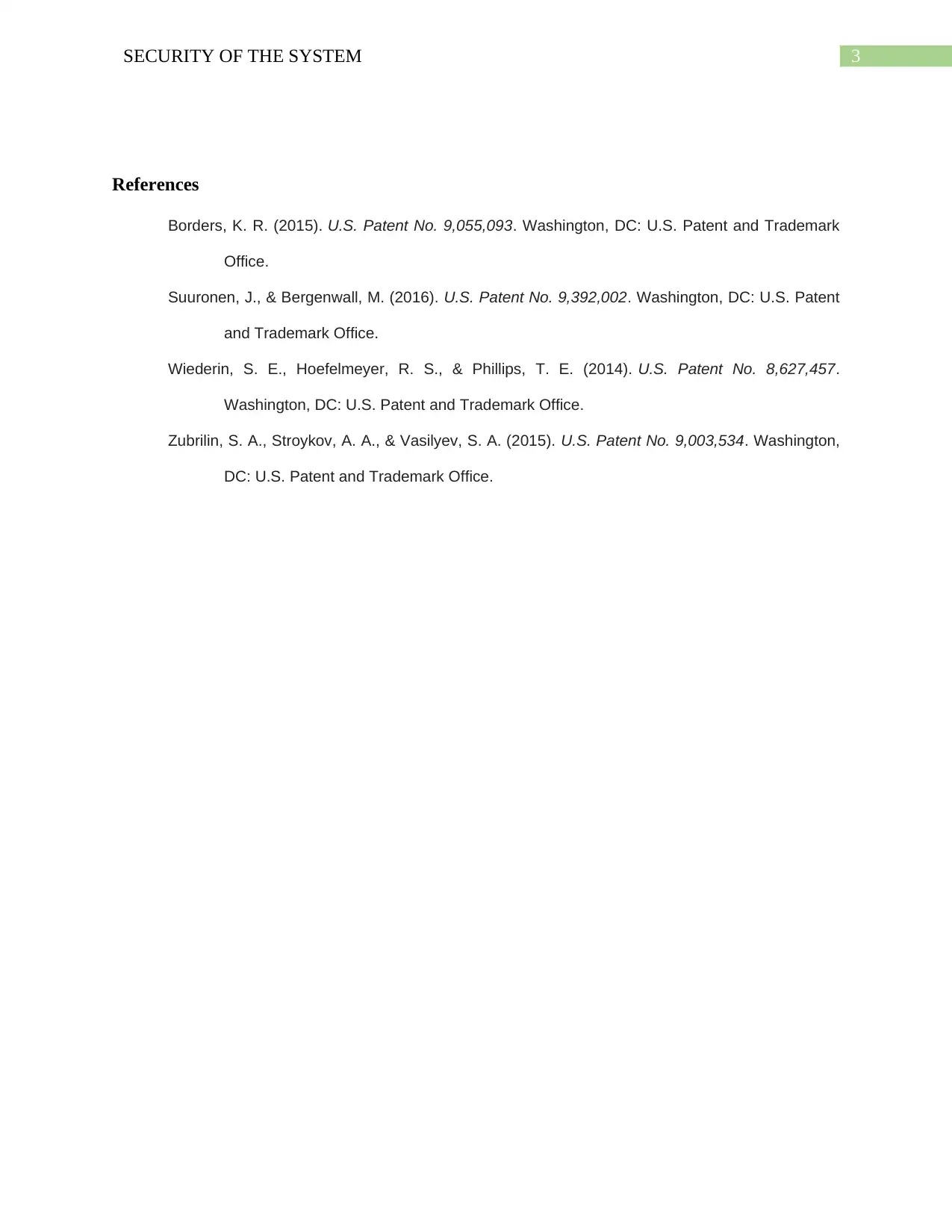Analyzing System Security: Ensuring Malware Freedom & Compliance
VerifiedAdded on 2023/06/10
|4
|727
|345
Homework Assignment
AI Summary
This assignment solution provides a detailed overview of system security, focusing on ensuring a malware-free environment. It defines what it means for a system to be malware-free, explains how anti-virus software can demonstrate this status, and outlines the steps to ensure a device remains free from malware. Furthermore, it addresses the process of verifying client or device compliance by ensuring updated anti-virus software is in use and highlighting the importance of maintaining both client and server systems malware-free for sustainable communication. The document also includes references to relevant patents and publications.

Running head: SECURITY OF THE SYSTEM
SECURITY OF THE SYSTEM
Name of the Student:
Name of the University:
Author Note:
SECURITY OF THE SYSTEM
Name of the Student:
Name of the University:
Author Note:
Paraphrase This Document
Need a fresh take? Get an instant paraphrase of this document with our AI Paraphraser

1SECURITY OF THE SYSTEM
1. Answer to the question no 1:
Meaning of malware free:
The meaning of malware free denotes that the system is free from the malware,
virus and other malicious codes and the programs, those can affect the systems and the
application in a negative way (Suuronen & Bergenwall,2016). The malware can be spread in
the system through the use of the external devices such as USB, or in case, if the user of
the system unintentionally open a suspicious link, the malware or the malicious piece of
code can run in the system.
The malware free system denotes that all the application in the system are valid and no
malicious piece of code is running in the background of the system. The malware free
system ensures safe data transmission and effective working environment for the users.
2. Answer to the question no 2:
Demonstration of the computer as malware free:
In a general way, the anti-virus software can show that the system is free from the
malware. A person can run the anti-virus software to check if the system is free from the
malware. However, while choosing the anti-virus software, the effectiveness of the
software is needed to be evaluated (Zubrilin,Stroykov & Vasilyev, 2015). A good anti-virus
software is able to detect the malware in system along with that it can also detect other
suspicious codes and application running behind the system. The anti-virus software is
needed to be updated, so that it can detect all present malwares.
3. Answer to the question no 3:
1. Answer to the question no 1:
Meaning of malware free:
The meaning of malware free denotes that the system is free from the malware,
virus and other malicious codes and the programs, those can affect the systems and the
application in a negative way (Suuronen & Bergenwall,2016). The malware can be spread in
the system through the use of the external devices such as USB, or in case, if the user of
the system unintentionally open a suspicious link, the malware or the malicious piece of
code can run in the system.
The malware free system denotes that all the application in the system are valid and no
malicious piece of code is running in the background of the system. The malware free
system ensures safe data transmission and effective working environment for the users.
2. Answer to the question no 2:
Demonstration of the computer as malware free:
In a general way, the anti-virus software can show that the system is free from the
malware. A person can run the anti-virus software to check if the system is free from the
malware. However, while choosing the anti-virus software, the effectiveness of the
software is needed to be evaluated (Zubrilin,Stroykov & Vasilyev, 2015). A good anti-virus
software is able to detect the malware in system along with that it can also detect other
suspicious codes and application running behind the system. The anti-virus software is
needed to be updated, so that it can detect all present malwares.
3. Answer to the question no 3:

2SECURITY OF THE SYSTEM
Steps to ensure that the device is malware free:
In order to detect if there is a malware in the system, the first step is to run a
malware program in the system. In case, if any malware program is present in the
computer, the users should remove that application (Wiederin, Hoefelmeyer & Phillips,
2014). The use of anti malware and anti virus software can also be used in this case. The
user can remove the malware function through the use of the anti malware software. The
regular schedule scanning is needed to be done after the removal of the malware
application or the function from the system.
4. Answer to the question no 4:
Verifying a client or device is compliant :
In order to verify a device or system is compliant, it is needed to be ensured that
the client devices and the systems are using the anti virus software. The anti virus
software the devices are using is needed to be updated, so that it can detect the latest
forms of malicious codes and the malwares (Borders, 2015). Both the client and the
servers are needed to be malware free, so that they can generate the communication in a
sustainable way. The anti virus software in the client devices and the system can be used
in an individual way. However, running the same anti virus software in all the system
will help to reduce the conflicts and the issues regarding the compatibility of the
software.
Steps to ensure that the device is malware free:
In order to detect if there is a malware in the system, the first step is to run a
malware program in the system. In case, if any malware program is present in the
computer, the users should remove that application (Wiederin, Hoefelmeyer & Phillips,
2014). The use of anti malware and anti virus software can also be used in this case. The
user can remove the malware function through the use of the anti malware software. The
regular schedule scanning is needed to be done after the removal of the malware
application or the function from the system.
4. Answer to the question no 4:
Verifying a client or device is compliant :
In order to verify a device or system is compliant, it is needed to be ensured that
the client devices and the systems are using the anti virus software. The anti virus
software the devices are using is needed to be updated, so that it can detect the latest
forms of malicious codes and the malwares (Borders, 2015). Both the client and the
servers are needed to be malware free, so that they can generate the communication in a
sustainable way. The anti virus software in the client devices and the system can be used
in an individual way. However, running the same anti virus software in all the system
will help to reduce the conflicts and the issues regarding the compatibility of the
software.
⊘ This is a preview!⊘
Do you want full access?
Subscribe today to unlock all pages.

Trusted by 1+ million students worldwide

3SECURITY OF THE SYSTEM
References
Borders, K. R. (2015). U.S. Patent No. 9,055,093. Washington, DC: U.S. Patent and Trademark
Office.
Suuronen, J., & Bergenwall, M. (2016). U.S. Patent No. 9,392,002. Washington, DC: U.S. Patent
and Trademark Office.
Wiederin, S. E., Hoefelmeyer, R. S., & Phillips, T. E. (2014). U.S. Patent No. 8,627,457.
Washington, DC: U.S. Patent and Trademark Office.
Zubrilin, S. A., Stroykov, A. A., & Vasilyev, S. A. (2015). U.S. Patent No. 9,003,534. Washington,
DC: U.S. Patent and Trademark Office.
References
Borders, K. R. (2015). U.S. Patent No. 9,055,093. Washington, DC: U.S. Patent and Trademark
Office.
Suuronen, J., & Bergenwall, M. (2016). U.S. Patent No. 9,392,002. Washington, DC: U.S. Patent
and Trademark Office.
Wiederin, S. E., Hoefelmeyer, R. S., & Phillips, T. E. (2014). U.S. Patent No. 8,627,457.
Washington, DC: U.S. Patent and Trademark Office.
Zubrilin, S. A., Stroykov, A. A., & Vasilyev, S. A. (2015). U.S. Patent No. 9,003,534. Washington,
DC: U.S. Patent and Trademark Office.
1 out of 4
Related Documents
Your All-in-One AI-Powered Toolkit for Academic Success.
+13062052269
info@desklib.com
Available 24*7 on WhatsApp / Email
![[object Object]](/_next/static/media/star-bottom.7253800d.svg)
Unlock your academic potential
Copyright © 2020–2025 A2Z Services. All Rights Reserved. Developed and managed by ZUCOL.





